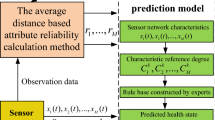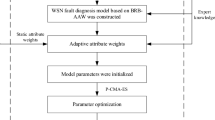Abstract
A belief rule-based (BRB) model with attribute reliability (BRB-r) has been developed recently, where the systematic uncertainty is regarded as attribute reliability by extending the traditional BRB model. The BRB-r model provides a framework to deal with the systematic uncertainty, but the drawbacks in modeling and inference reduces the accuracy of it. This paper proposed a new modeling and inference approach to improve the effectiveness of the BRB-r. This approach is constituted by two parts: data processing and BRB inference. In the data processing, the attribute reliability is calculated based on the auto regressive model, while the parameters of BRB-r are optimized using the differential evolution algorithm. In the BRB inference, a new attribute reliability fusion algorithm is proposed, which can effectively integrate attribute reliability into the BRB model and ensure the rationality in different situations. A benchmark case about pipeline leak detection and a practical case about condition monitoring are studied to demonstrate the rationality and feasibility of the proposed approach to the BRB-r model.








Similar content being viewed by others
References
Aghakouchak A, Mehran A, Norouzi H, Behrangi A (2012) Systematic and random error components in satellite precipitation data sets. Geophys Res Lett 39(9):9406
Anderson S (2008) Damage propagation modeling for aircraft engine run-to-failure simulation. In: International conference on prognostics & health management, pp 1–9
Chang LL, Zhou ZJ, Chen YW, TJ Liao Y H u, Yang LH (2018) Belief rule base structure and parameter joint optimization under disjunctive assumption for nonlinear complex system modeling. IEEE Trans Syst Man Cybern Syst 48(9):1542–1554
Chen MY (2011) Predicting corporate financial distress based on integration of decision tree classification and logistic regression. Expert Syst Appl 38(9):11261–11272
Chen YW, Yang JB, Pan CC, Xu DL, Zhou ZJ (2015) Identification of uncertain nonlinear systems: constructing belief rule-based models. Knowl-Based Syst 73:124–133
Chen YW, Yang JB, Xu DL, Zhou ZJ, Tang DW (2011) Inference analysis and adaptive training for belief rule based systems. Expert Syst Appl 38(10):12845–12860
Chen Y, Chen YW, Xu XB, Pan CC, Yang JB, Yang GK (2015) A data-driven approximate causal inference model using the evidential reasoning rule. Knowl-Based Syst 88(C):264–272
Dempster AP (1968) A generalization of Bayesian inference. J R Stat Soc 30(2):205–247
Feng ZC, Zhou ZJ, Hu CH, Chang LL, Hu GY, Zhao FJ (2018) A new belief rule base model with attribute reliability. IEEE Trans Fuzzy Syst PP(99):1–1
Gupta HV, Kling H, Yilmaz KK, Martinez GF (2009) Decomposition of the mean squared error and nse performance criteria: implications for improving hydrological modelling. J Hydrol 377(1):80–91
Hertwich EG, Mckone TE, Pease WS (2010) A systematic uncertainty analysis of an evaluative fate and exposure model. Risk Anal 20(4):439–454
Kong GL, Xu DL, Yang JB, Yin XF, Wang TB, Jiang BG, Hu YH (2016) Belief rule-based inference for predicting trauma outcome. Knowl-Based Syst 95(C):35–44
Laha AK (2019) A hybrid modelling method for time series forecasting based on a linear regression model and deep learning. (Chapter 2):13–19
Lal A, Datta B (2018) Development and implementation of support vector machine regression surrogate models for predicting groundwater pumping-induced saltwater intrusion into coastal aquifers. Water Resour Manag, 1–15
Lu Y, Gao F (2005) A novel time-domain auto-regressive model for structural damage diagnosis. J Sound Vibr 283(3):1031–1049
Mcleod AI, Zhang Y (2010) Partial autocorrelation parameterization for subset autoregression. J Time 27 (4):599–612
Saxena A, Goebel K (2008) CA NASA Ames research center, Moffett Field. Turbofan engine degradation simulation data set. https://ti.arc.nasa.gov/tech/dash/groups/pcoe/prognostic-data-repository/#phm08_challenge
Phillips CV (2003) Quantifying and reporting uncertainty from systematic errors. Epidemiology 14(4):459–466
Qian B, Wang QQ, Hu R, Zhou ZJ, Yu CQ, Zhou ZG (2017) An effective soft computing technology based on belief-rule-base and particle swarm optimization for tipping paper permeability measurement. J Ambient Intell Humanized Comput 15:1–10
Rosner B, Grove D (1999) Use of the mann-whitney u-test for clustered data. Stat Med 18(11):1387–1400
Song YF, Wang XD, Zhu JW, Lei L (2018) Sensor dynamic reliability evaluation based on evidence theory and intuitionistic fuzzy sets. Appl Intell 48(1):1–13
Stadnytska T (2010) Deterministic or stochastic trend: decision on the basis of the augmented dickey-fuller test. Methodology European Journal of Research Methods for the Behavioral & Social Sciences 6(2):83–92
Suzuki E, Tsuda T, Mitsuhashi T, Mansournia MA, Yamamoto E (2016) Errors in causal inference: an organizational schema for systematic error and random error. Ann Epidemiol 26(11):788–793.e1
Wang YM, Yang LH, Fu YG, Chang LL, Chin KS (2016) Dynamic rule adjustment approach for optimizing belief rule-base expert system. Knowl-Based Syst 96(C):40–60
Xie F, Xu Y (2019) An efficient regularized k-nearest neighbor structural twin support vector machine. Appl Intell PP:1–18
Xu DL, Liu J, Yang JB, Liu GP, Wang J, Jenkinson I, Ren J (2007) Inference and learning methodology of belief-rule-based expert system for pipeline leak detection. Expert Syst Appl 32(1):103–113
Xu DW, Wang YD, Peng P, Shen BL, Deng Z, Guo HF (2018) Real-time road traffic state prediction based on kernel-knn. Appl Intell, 1–23
Yang JB (2001) Rule and utility based evidential reasoning approach for multiattribute decision analysis under uncertainties. Eur J Oper Res 131(1):31–61
Yang JB, Liu J, Jin W, Sii HS, Wang HW (2006) Belief rule-base inference methodology using the evidential reasoning approach-rimer. IEEE Trans Syst Man Cybern Part A Syst Humans 36(2):266–285
Yang JB, Liu J, Xu DL, Wang J, Wang H (2007) Optimization models for training belief-rule-based systems. IEEE Trans Syst Man Cybern - Part A: Syst Humans 37(4):569–585
Yang JB, Xu DL (2013) Evidential reasoning rule for evidence combination. Artif Intell 205(205):1–29
Yang LH, Wang YM, Liu J, Martínez L (2018) A joint optimization method on parameter and structure for belief-rule-based systems. Knowl-Based Syst 142:220–240
Zhou ZG, Liu F, Jiao LC, Zhou ZJ, Yang JB, Gong MG, Zhang XP (2013) A bi-level belief rule based decision support system for diagnosis of lymph node metastasis in gastric cancer. Knowl-Based Syst 54 (4):128–136
Zhou ZJ, Feng ZC, Hu CH, Zhao FJ, Hu GY (2017) Fault detection based on belief rule base with online updating attribute weight. In: Automation, pp 272–276
Zhou ZJ, Hu CH, Xu DL, Chen MY, Zhou DH (2010) A model for real-time failure prognosis based on hidden Markov model and belief rule base. Eur J Oper Res 207(1):269–283
Zhou ZJ, Hu CH, Yang JB, Xu DL, Zhou DH (2009) Online updating belief rule based system for pipeline leak detection under expert intervention. Expert Syst Appl 36(4):7700–7709
Zhu WD, Liu F, Chen YW, Yang JB, Xu DL, Wang DP (2015) Research project evaluation and selection: an evidential reasoning rule-based method for aggregating peer review information with reliabilities. Scientometrics 105(3):1469–1490
Acknowledgements
This work was supported in part by the National Key R&D Program of China under Grant No. SQ2017YFSF070185 and the National Natural Science Foundation of China under Grant 71901212 and Grant 71690233 and Grant 71671186, and in part by the Research Project of National University of Defense Technology.
Author information
Authors and Affiliations
Corresponding authors
Additional information
Publisher’s note
Springer Nature remains neutral with regard to jurisdictional claims in published maps and institutional affiliations.
Appendix
Appendix
Rights and permissions
About this article
Cite this article
You, Y., Sun, J., Jiang, J. et al. A new modeling and inference approach for the belief rule base with attribute reliability. Appl Intell 50, 976–992 (2020). https://doi.org/10.1007/s10489-019-01586-2
Published:
Issue Date:
DOI: https://doi.org/10.1007/s10489-019-01586-2




